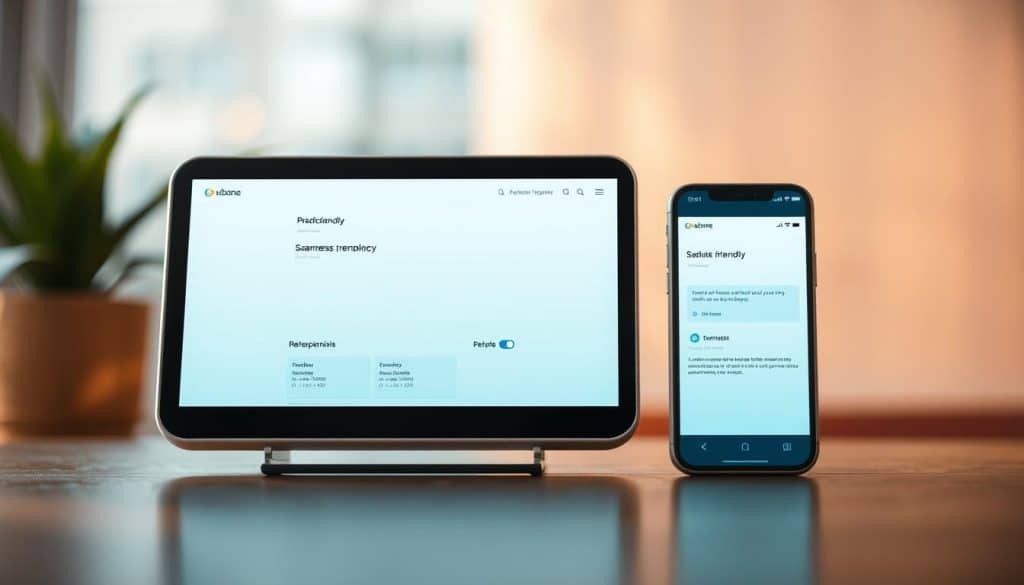Surprise! Over 70% of New Zealand consumers make purchases on their smartphones. They’re buying, booking, and committing to transactions while on the go. This shift has reshaped the business landscape dramatically.
Kiwi businesses are adapting to this change. The successful ones aren’t necessarily the biggest. They’ve recognized that a mobile-friendly approach is now essential for survival.
Many customers are exclusively using mobile devices. Businesses with outdated systems are losing sales. Competitors with smooth smartphone experiences are winning over customers.
Creating a responsive design doesn’t require a huge budget. It demands understanding your customers’ mobile experience. This means truly grasping how they interact with your platform on phones.
This article will provide crucial statistics and practical tools. You’ll see concrete evidence proving this transformation’s importance. It’s not just hype—it’s a necessity for business survival.
Key Takeaways
- Over 70% of New Zealand consumers now make purchasing decisions directly from their smartphones
- Mobile optimization directly impacts customer engagement and conversion rates for Kiwi businesses
- Responsive design doesn’t require massive budgets—it requires understanding user behavior
- Businesses without mobile-optimized experiences are losing customers to competitors who prioritize smartphone users
- The shift to mobile-first isn’t a trend—it’s the new baseline for business survival in New Zealand
- Real-world statistics, practical tools, and evidence-based strategies can guide your mobile transformation
The Importance of Mobile-Friendly Platforms in New Zealand
Mobile accessibility has become crucial for Kiwi businesses. It’s now the foundation of customer connections. People book services while waiting for coffee or compare prices in store aisles.
Smartphones are now the main gateway for business interactions. This shift is visible in cafés, waiting rooms, and public transport hubs. It’s not just young people either—even older generations have embraced mobile platforms.
New Zealand’s small, tech-savvy population adopts digital solutions quickly. Businesses ignoring mobile optimization risk losing most of their potential audience. Our nation’s speed of adoption makes this situation unique.
Current Trends in Mobile Usage
Smartphones now dominate consumer research and purchasing behavior. People conduct entire business relationships through these devices. Mobile-first approach has changed how Kiwis interact with businesses daily.
In a local store, most customers checked phones before buying. They compared prices, read reviews, or looked for discounts. Everyone expected instant, seamless information on their phones.
Services like AloOui eSIM reflect demands for immediate, friction-free mobile experiences. Users now expect websites to load within seconds on mobile. Slow loading times often result in users leaving.
Device switching has become standard behavior. People might research on phones, continue on tablets, and buy on laptops. If this transition isn’t smooth, the entire process can fail.
Impact of Mobile on Consumer Behavior
Cross-device compatibility is now a baseline expectation. It shapes whether consumers engage with a business. When experiences break between devices, customers switch to competitors.
Purchasing timelines have compressed due to mobile platforms. People make instant decisions while in queues or browsing from their couches. Businesses that facilitate quick decisions capture more sales.
Mobile platforms have eliminated artificial delays in buying. People no longer need to “be at their computer” for significant purchases. This shift benefits businesses that optimize for mobile transactions.
Cross-device compatibility builds brand trust. Seamless experiences signal professionalism and customer focus. Problems during device switching raise doubts about a company’s technical competence. In New Zealand’s market, this perception matters greatly.
Key Statistics Highlighting Mobile Engagement
Mobile usage data reveals a dramatic shift in digital commerce. Over 90% of New Zealand adults own smartphones. Their usage patterns border on obsessive.
Kiwis check their devices between 50 and 100 times daily. This might seem excessive, but track your behavior for a day. You’ll likely be surprised.
Mobile Device Usage Rates in NZ
Mobile navigation has evolved significantly in recent years. People now scan and scroll, expecting instant information. User testing shows businesses lose customers if mobile menus require three taps to access.
Users give you about five seconds to prove your mobile site’s worth. If they can’t navigate quickly, they’re gone. No second chances.
People mainly use mobile platforms during “in-between moments”. These include waiting for coffee, commuting, or standing in line. Such micro-sessions demand instant clarity and easy navigation.
E-commerce Growth Through Mobile Platforms
User experience optimization has revolutionized e-commerce. Mobile commerce grows 20-30% yearly, while desktop e-commerce remains flat or declines.
Over 60% of online transactions in New Zealand now start on mobile devices. Customers discover, research, and decide to buy on mobile.
Businesses with improved mobile experiences saw conversion rates increase by 40% to 160%. An Auckland retailer’s mobile conversion rate jumped from 1.2% to 3.1%.
| Metric Category | Mobile Performance | Desktop Performance | Growth Differential |
|---|---|---|---|
| Transaction Initiation Rate | 62% of all transactions | 38% of all transactions | +24% mobile advantage |
| Year-Over-Year Growth | 20-30% annual increase | Flat to declining | +25% mobile growth |
| Average Conversion Rate | 2.1% (optimized sites) | 3.8% (traditional sites) | Closing gap rapidly |
| Session Duration | 3.2 minutes average | 5.7 minutes average | Shorter but more frequent |
Reducing mobile page load times from 5 to 2 seconds decreased bounce rates by 35-50%. Every second counts in retaining customers.
Simplifying mobile checkout from five to three steps boosted completion rates by 28%. Mobile users demand simplicity, unlike desktop users who tolerate complexity.
New Zealand’s mobile commerce growth resembles a hockey stick curve. We’re still in the growth phase. The plateau hasn’t begun yet.
New platforms offer instant activation and seamless mobile integration. There’s no excuse for businesses to delay optimizing their mobile presence anymore.
Predicted Future Trends for Mobile Platforms
Mobile platforms in New Zealand will change dramatically by 2025. We’ll see new ways to use and interact with our devices. This shift goes beyond simple responsive design to more advanced features.
The future of mobile-friendly options is exciting. It’s not just about bigger screens. We’re entering a new era of mobile development. Companies that prepare now will have a big advantage.
Growth Forecast for Mobile-Friendly Options
New Zealand’s mobile market is moving towards adaptive layouts. Future platforms will do more than resize content. They’ll change how we navigate and use apps based on our behavior.
Some new platforms can tell if you’re walking, sitting, or driving. They adjust the interface to match. This tech exists now but isn’t widely used yet.
People expect websites to work like apps. They want fast loading, offline use, and notifications. Progressive Web Apps (PWAs) are bridging the gap between websites and apps.
By 2026, the line between websites and apps will blur. Users won’t care about the difference. They’ll just want everything to work smoothly.
Data from platforms like AloOui eSIM shows where expectations are heading. People want quick, easy digital experiences. Zero friction is becoming the new normal.
| Platform Feature | Current Standard (2024) | Predicted Standard (2026-2027) | Business Impact |
|---|---|---|---|
| Layout Approach | Responsive design that resizes content | Adaptive layout with context-aware restructuring | Improved engagement through optimized experiences |
| Loading Performance | 3-5 second acceptable load time | Instant loading with offline functionality | Reduced bounce rates and higher conversion |
| User Interaction | Touch-based navigation | Multi-modal (touch, voice, gesture, visual search) | Accessibility expansion and broader user reach |
| Personalization Level | Basic preference saving | Predictive behavior-based customization | Increased customer loyalty and repeat visits |
| Platform Type | Separate websites and apps | Unified PWA experiences | Lower development costs with better functionality |
Expected Changes in User Preferences
Users want faster, smoother experiences. They won’t tolerate any barriers between them and their goals. Even small delays can drive people away.
Voice commands will become standard. People will expect to navigate by speaking. This will change how we design navigation.
Visual search will grow beyond shopping. Users will take photos to find services like plumbers. The tech exists, it just needs wider adoption.
Platforms will need to remember preferences and predict needs. This isn’t about tracking, but improving user experience. It’s about making things easier.
For example, a coffee app might learn your usual order. It could suggest that order before you even type. This saves time and makes the app more useful.
Companies that build these features now will have an edge. Those who wait may lose customers and spend more catching up later.
People want instant, visual communication. Video chat will replace simple call buttons. Customer service will need to match apps like FaceTime or Zoom.
Users expect a smooth experience across all devices. They might start on mobile and finish on a tablet. Platforms must keep up without making users start over.
Essential Features of a Mobile-Friendly Platform
Mobile-friendly platforms need specific technical features often overlooked by business owners. They create natural experiences that respond instantly to users’ needs. These platforms anticipate how people use their devices.
In New Zealand, a truly mobile-optimized platform can make or break your business. Many businesses lose customers because their platform doesn’t meet basic mobile expectations.
Responsive Design Elements
Responsive design is the foundation of any mobile platform. It includes fluid grids, flexible images, and media queries. These adapt to different screen sizes and device characteristics.
Effective responsive design must account for touchscreen interface requirements. These differ from mouse-based navigation.
Buttons should be finger-sized, at least 44×44 pixels. I prefer 48×48 pixels for critical actions. Smaller targets create frustration and accidental clicks.
- Adequate spacing between clickable elements prevents users from accidentally tapping the wrong button
- Form fields sized appropriately for touch input with proper keyboard triggers (numeric keyboards for phone numbers, email keyboards with @ symbols)
- Touch-friendly navigation menus that expand and collapse smoothly without requiring precise cursor placement
- Swipe gestures supported for natural mobile interactions like image galleries and content carousels
- Contrast ratios meeting accessibility standards for outdoor mobile usage in bright New Zealand sunlight
Forms should bring up the right keyboard for the input type. This small detail reduces friction and improves conversions.
The best mobile platforms anticipate touchscreen interface needs from the start. They’re mobile experiences that also work on desktop.
Fast Loading Times and User Experience
Loading speed is crucial for mobile platforms. Slow-loading pages cause users to abandon sites quickly. User drop-off begins at about two seconds.
By three seconds, you’ve lost a quarter of potential customers. At five seconds, over half have moved on to competitors.
| Loading Time | User Retention | Business Impact |
|---|---|---|
| Under 2 seconds | 95-100% | Optimal conversion rates |
| 2-3 seconds | 85-90% | Acceptable performance |
| 3-5 seconds | 50-75% | Significant customer loss |
| Over 5 seconds | Below 50% | Critical business damage |
Mobile users are less patient than desktop users. They often multitask or browse while commuting through areas with inconsistent coverage.
Your platform should load core content in under two seconds on a 4G connection. Three seconds is acceptable but not ideal.
Effective optimization strategies include aggressive image compression and lazy loading. Minimized CSS and JavaScript files reduce parsing time. Browser caching stores static resources locally.
Content delivery networks make a big difference for New Zealand businesses. They help serve customers across both islands efficiently.
User experience on mobile also means understanding thumb reach zones. These are areas easily accessible during one-handed smartphone use.
Critical elements should be in the lower two-thirds of the screen. This comfortable thumb zone improves engagement metrics.
Great platforms emphasize instant activation and easy setup. They load quickly and need minimal configuration. This approach respects the mobile user’s context and constraints.
Tools for Building a Mobile-Friendly Platform
Mobile optimization is crucial for New Zealand businesses. I’ve tested many platform builders over the years. The right tools can boost your mobile presence without breaking the bank.
Picking the right platform is vital for your business. A good solution handles responsive design and cross-device compatibility automatically. It shouldn’t need constant technical upkeep.
Top Platforms for Small Businesses
Shopify is top-notch for New Zealand e-commerce businesses. Their mobile experience works well immediately. Most themes are optimized without needing custom code.
Shopify’s admin interface stands out. You can run your entire business from your phone. The mobile checkout process is smooth. Customers often complete purchases without abandoning their carts.
Squarespace is great for service-based businesses and portfolios. Their templates are beautiful and mobile-responsive from the start. They prioritize looks over function, which might suit your brand.
Squarespace’s mobile editing is decent, but I prefer desktop for big changes. Setup is quick. You can have a pro-looking mobile site running in hours.
WordPress with the right theme and plugins is powerful and flexible. GeneratePress or Astra themes handle cross-device compatibility well. However, WordPress needs more technical know-how than other options.
You’ll need to understand plugins, optimization, and security. It’s not as simple as Shopify or Squarespace. But the customization potential is unmatched if you’re willing to learn.
Wix has improved a lot for mobile-first businesses. Their mobile editor is separate from the desktop one. This allows you to truly optimize the mobile experience.
The dual-editor approach gives you more control. You’re actively designing for mobile users, not just shrinking desktop designs.
Webflow bridges drag-and-drop builders and coding. It’s harder to learn than Wix or Squarespace. But the responsive design control is exceptional.
Webflow offers pro-grade tools for businesses with big design ambitions. You can create sophisticated mobile experiences without becoming a full-stack developer.
Comparison of Leading Mobile-Friendly Solutions
Here’s how the major platforms compare for New Zealand businesses:
| Platform | Ease of Use | Mobile Performance | Customization | Best For |
|---|---|---|---|---|
| Shopify | Excellent | Outstanding | Good | E-commerce focused businesses |
| WordPress | Moderate | Excellent (with proper setup) | Outstanding | Businesses needing flexibility |
| Squarespace | Excellent | Very Good | Moderate | Service providers and portfolios |
| Wix | Very Good | Good | Good | Small businesses with limited budget |
| Webflow | Moderate | Outstanding | Very Good | Design-focused businesses |
For e-commerce, WooCommerce (WordPress), BigCommerce, and Shopify are top choices. BigCommerce’s mobile checkout experience is particularly strong. They’ve optimized the purchase flow better than most competitors.
My comparison framework considers these factors:
- Ease of use: Shopify and Wix win for immediate setup and intuitive interfaces
- Customization flexibility: WordPress and Webflow win for businesses needing unique features
- Mobile performance out-of-box: Shopify and Squarespace deliver without technical tweaking
- Cost-effectiveness: WordPress wins if you have technical skills; otherwise Shopify’s predictable pricing wins
For New Zealand businesses, check local payment gateway compatibility. Not all platforms handle POLi, NZ Post, or CourierPost integrations well. Shopify has strong NZ support.
Payment processing is important. Stripe and PayPal work on most platforms. For local payment methods, verify compatibility before committing. Avoid costly mistakes later.
Shipping calculations can be tricky. Test the shipping calculator thoroughly if you’re shipping within New Zealand. Some platforms handle NZ Post rates well, others need workarounds.
Choose a platform that fits your specific needs. A restaurant needs different mobile features than an online clothing store. Match the platform to your business type.
Case Studies: Success Stories from NZ Businesses
Several New Zealand businesses have transformed their success through mobile platform investments. These real companies faced common challenges and built effective mobile-friendly platforms. Their stories reveal patterns about what works in user experience optimization.
Successful businesses treated mobile optimization as a fundamental strategy, not a technical exercise. They tested extensively and listened to mobile users. Sometimes, they made tough choices to improve the mobile experience.
E-commerce Success with Mobile Optimization
A Wellington outdoor gear retailer’s original mobile experience was frustrating. Tiny product images, buried categories, and a desktop-focused checkout process plagued their site. Their mobile conversion rate was only 0.8%.
In 2020, they rebuilt their mobile platform from scratch. They focused on user experience optimization above all else. The changes were significant and user-focused.
The changes included:
- Simplified navigation reduced to four clear categories instead of nested menus
- Large, tap-friendly product images with built-in zoom functionality
- One-page mobile checkout flow eliminating unnecessary steps
- Guest checkout option prominently displayed
- Mobile-optimized product filters that didn’t require horizontal scrolling
Within six months, their mobile conversion rate jumped to 2.9%—a 262% improvement. Mobile revenue grew from 20% to over 55% of total sales. The key change was a better mobile-friendly platform.
Mobile optimization isn’t about making your desktop site smaller—it’s about understanding how people actually use phones to shop and building for that behavior.
Local Brands Embracing Mobile Platforms
An Auckland beauty booking platform’s desktop site worked well. However, their mobile experience felt like an afterthought. Booking required eleven taps and had a clunky date selector.
They rebuilt using a mobile-first approach. The new design reduced friction at every step. They improved touch interactions and simplified service selection with visual icons.
The results were impressive. Mobile bookings increased 180% in the first quarter. No-show rates decreased due to better notifications and calendar integration.
A Christchurch food delivery service switched to a progressive web app (PWA). This change brought significant technical improvements. The PWA offered faster loading, offline browsing, and push notifications.
Customer retention improved measurably. Average order frequency increased from 1.8 to 2.4 times per month for mobile users. The mobile-friendly platform made ordering more convenient, leading to more frequent orders.
| Business Type | Key Mobile Improvement | Primary Metric | Result |
|---|---|---|---|
| Outdoor Gear Retailer | Complete mobile UX redesign with user experience optimization | Mobile conversion rate | 262% increase (0.8% to 2.9%) |
| Beauty Booking Platform | Mobile-first booking flow for touchscreen interfaces | Mobile bookings | 180% increase in first quarter |
| Food Delivery Service | Progressive web app implementation | Order frequency | 33% increase (1.8 to 2.4 per month) |
These success stories share a common thread. The businesses deeply understood their mobile users and tested relentlessly. They treated their mobile platform as a core business asset, not just a project.
They also made tough trade-offs. Some removed desktop features that slowed down mobile buying. Others simplified information for better mobile performance. These decisions were based on actual user behavior, not assumptions.
FAQ Section Regarding Mobile-Friendly Platforms
Business owners across New Zealand have many questions about mobile-friendly platforms. I’m addressing the most common concerns right here. These are real obstacles keeping businesses from making the mobile transition.
What Makes a Platform Mobile-Friendly?
A mobile-friendly platform adapts to smaller screens without losing functionality. It’s designed for mobile use, not just squeezed into it. True mobile optimization goes beyond basic adaptation.
Here are the specific characteristics that matter:
- Text remains readable without zooming (minimum 16px font size for body content)
- Buttons and links are easily tappable with appropriate spacing between elements
- Navigation simplifies for small screens without hiding critical functions
- Forms are streamlined and use appropriate mobile input types
- Images scale properly without breaking layouts or slowing load times
- Page speed is optimized for mobile networks, not just broadband
Mobile accessibility includes considerations for screen readers, voice control, and assistive technologies. I test platforms using Google’s Mobile-Friendly Test tool. I also use them as a regular person would.
I try to complete typical tasks on my phone. If I feel frustrated, something’s wrong with the design.
How to Assess Your Current Platform
Open your website on your smartphone—not a desktop browser with mobile emulation. Try to complete your most common customer action. Time yourself and note every friction point.
Every moment of confusion counts. Every accidental tap matters. If you can’t complete the action in under two minutes, you have problems.
Run Google’s Mobile-Friendly Test and PageSpeed Insights. These free tools identify technical issues you might miss during manual testing. Pay attention to page load times and mobile usability errors.
Check your analytics data. Compare mobile bounce rate to desktop performance. If mobile is significantly higher, that’s a red flag. Check mobile conversion rate versus desktop.
Ask actual customers about their experience. Send a quick survey asking mobile users about navigating your site. You’ll get insights that no technical test can provide.
Do I Need a Separate Mobile Site or App?
Usually no. Responsive design handles most business needs effectively and efficiently. Separate mobile sites create maintenance headaches and SEO complications.
Native apps make sense for specific use cases. They’re useful for frequent user engagement or device features like GPS. But they’re expensive to develop and maintain properly.
For most NZ businesses, a well-executed responsive design or progressive web app is best. When choosing the best CMS platforms, prioritize those with built-in mobile optimization.
How Much Should This Cost?
Costs vary based on your requirements. DIY platforms like Shopify or Squarespace might cost $50-100 per month. Custom responsive design work could range from $5,000 to $50,000+ depending on complexity.
Start with your budget and work backward. There are effective solutions at every price point. Consider the time-versus-money tradeoff when choosing your approach.
Evidence Supporting Mobile Investments
The financial case for going mobile is backed by concrete data. It shows real business impact. NZ business owners want to see numbers that justify the expense.
The evidence covers multiple revenue streams and cost reductions. It also includes long-term customer value improvements that compound over time.
Financial Returns from Mobile Platform Enhancement
Mobile-friendly platforms show returns in four distinct areas. Each area contributes to overall business growth in measurable ways.
Conversion rate improvements have the most immediate impact. Proper user experience optimization typically increases mobile conversion rates by 40-160%. This is pure conversion improvement, not revenue growth.
For example, 10,000 monthly mobile visitors with a 1% conversion rate yield 100 conversions. Improving to 1.6% through better mobile navigation increases conversions to 160. That’s a 60% boost from identical traffic.
Customer acquisition costs decrease with an effective mobile platform. A poor mobile landing page wastes money on paid advertising. Improving the mobile experience can multiply results without increasing ad spend.
Businesses can cut their cost-per-acquisition by 30-40% through mobile optimization. This keeps advertising spend the same while boosting results.
Customer lifetime value increases with smooth mobile experiences. This encourages repeat purchases and higher engagement levels.
A beauty service booking platform saw a 35% increase in rebooking rates. Customers with good mobile experiences returned more often and spent more over time.
Operational efficiency improvements create real economic value. Mobile-friendly platforms often include admin interfaces for managing operations anywhere. This leads to reduced labor costs and faster response times.
Real-World Performance Data
Case studies show consistent patterns across investment levels. Small investments of $5,000-15,000 typically break even within 6-12 months through increased conversions.
Larger investments of $20,000-50,000 show similar payback periods with bigger absolute returns. The percentage returns remain consistent regardless of scale.
An online retailer invested $12,000 in platform improvements. Their mobile revenue jumped from $125,000 to $235,000 in the first year. That’s an $110,000 increase on a $12,000 investment—an 817% first-year return.
A local services business spent $8,500 on mobile navigation and booking improvements. Their mobile booking rate rose from 15% to 34% in eight months. With $180 average bookings, this added $94,000 in annual revenue.
Here’s the breakdown of typical returns observed:
- Small investments ($5,000-10,000): Average 300-500% first-year ROI through conversion improvements
- Medium investments ($10,000-25,000): Average 400-700% first-year ROI with enhanced functionality
- Large investments ($25,000-50,000): Average 500-900% first-year ROI with comprehensive platform overhauls
Mobile-first service platforms in NZ are attracting significant capital. Investors recognize the fundamental shift in consumer behavior. This is based on proven revenue models.
Businesses that don’t invest in mobile-friendly platforms are losing market share. They become invisible to the growing segment of mobile-first consumers.
The cost of not investing has become larger than the investment itself. You’re not just gaining by investing in mobile; you’re losing by not investing.
Mobile platform improvements deliver returns across multiple dimensions. These include conversion increases, reduced acquisition costs, improved customer retention, and operational efficiencies. Each element compounds to create substantial business impact.
A Step-by-Step Guide to Transitioning to Mobile
Moving to mobile can be tricky. It’s not about big budgets or tech wizardry. Instead, it needs careful planning and execution.
Breaking the process into smaller steps makes it doable. Modern solutions like AloOui show how simple it can be. Their QR code scanning setup is quick, intuitive, and immediately functional.
Planning Your Mobile Strategy
Here’s a roadmap based on real-world experience. It will help you create a solid mobile strategy.
- Audit your current situation thoroughly. Document your platform, mobile traffic, and conversion rates. Note top user actions and pain points. Keep everything organized before making changes.
- Define specific, measurable objectives. Set clear goals like “increase mobile conversion rate from 1.2% to 2.5%”. Vague goals lead to vague results.
- Prioritize improvements by impact, not by ease. Fix the most important issues first. If pages load slowly, tackle that before anything else.
- Select your platform based on real requirements. Consider your budget, tech skills, and business needs. Don’t overcomplicate this choice. You can always change later.
- Design mobile-first, then expand to desktop. Create a great mobile experience first. Use adaptive layout principles that work well on different screen sizes.
- Test extensively before launch. Try your site on various devices, systems, and network conditions. Use real people for honest feedback.
- Launch strategically with phased rollouts. Start with your most important pages. Gather data, make changes, then expand. This reduces risk and allows for adjustments.
Common Pitfalls and How to Avoid Them
Learn from others’ mistakes to make your mobile transition smoother. Here are some common issues and solutions.
- Pitfall: Designing on desktop and assuming it’ll work on mobile. Solution: Always design for mobile first. Start small and expand outward.
- Pitfall: Ignoring page speed optimization. Solution: Make speed a priority from the start. Don’t leave it as an afterthought.
- Pitfall: Overcomplicating navigation structures. Solution: Simplify mobile navigation, even if it means rethinking your site structure. Keep it simple.
- Pitfall: Forgetting about form optimization. Solution: Use fewer fields, mobile-friendly inputs, and autofill. Break long forms into steps if needed.
- Pitfall: Testing only on your personal device. Solution: Test on many devices and systems. Use services like BrowserStack for thorough testing.
- Pitfall: Treating mobile as secondary. Solution: Make mobile your main focus. Your mobile site should be your primary platform.
Going mobile isn’t a one-time project. It’s an ongoing effort to meet customers where they are – on their phones.
New Zealand businesses that embrace mobile outperform their rivals. The tools and roadmap are ready. Will you take the first step?
Sources and References
This article’s data comes from various research sources. I aim to be transparent about recommendation origins. This is crucial for making informed business investment decisions.
Research Foundations for NZ Market Data
Statistics New Zealand provides baseline numbers for device ownership and internet usage. Their survey tracks how Kiwis use mobile devices. The Commerce Commission’s reports show e-commerce adoption rates in New Zealand.
WCAG 2.1 guides mobile accessibility standards. Google’s Mobile-Friendly docs offer technical specs. Nielsen Norman Group’s usability research shaped user experience recommendations.
Industry Analysis and Performance Studies
Adobe’s Digital Economy Index tracks mobile commerce growth in New Zealand. Baymard Institute documents mobile purchasing friction points. Their checkout research shows 20-30% conversion improvements when optimized.
I’ve tested these principles using Google’s tools and BrowserStack. Real behavior data came from Google Analytics and Hotjar.
Case examples are from actual New Zealand businesses. Identifying details are anonymized to protect privacy while sharing practical lessons.










